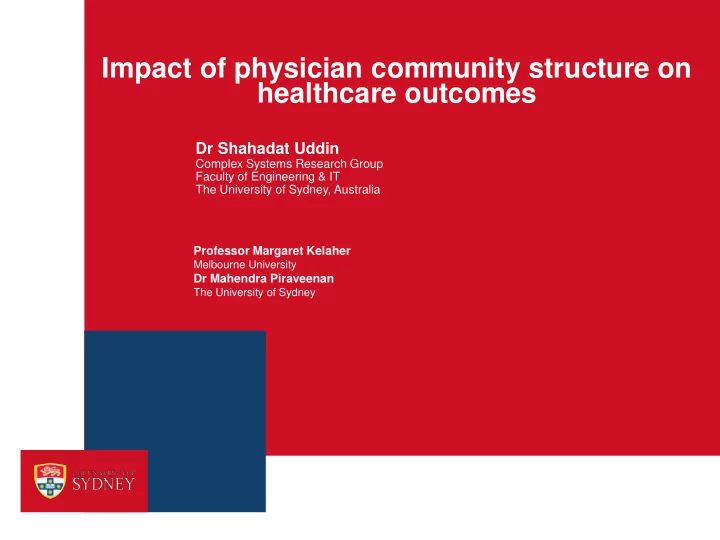

Impact of physician community structure on healthcare outcomes Dr Shahadat Uddin Complex Systems Research Group Faculty of Engineering & IT The University of Sydney, Australia Professor Margaret Kelaher Melbourne University Dr Mahendra Piraveenan The University of Sydney
Physician community and Healthcare outcomes Agenda Establishing the research context: the use of electronic health data (EHD) Social network and community detection Capturing physician collaboration network (PCN) from EHD Exploring impact of physician community on healthcare outcome Conclusion and future research direction
Physician community and Healthcare outcomes Research context and Electronic health data With the advent of modern technology, the volume of electronic health data (EHD) has been increasing exponentially over the time. Although EHD are mainly maintained for billing and administrative purposes, this type of dataset has already shown wide acceptability to the present healthcare research community. This has been reflected in the volume of recent research outcome based on EHD. Number of publication based on EHD over time Number of publications 5000 4000 3000 2000 1000 0 2004 2005 2006 2007 2008 2009 2010 2011 2012 2013 Year In this study, we will show another usage of EHD for research investigation. In particular, we will: Show how to capture physician collaboration network (PCN) from EDA From this PCN, we will show how to extract physician communities Finally, explore how physician communities affect patients’ healthcare outcome (readmission and cost)
Physician community and Healthcare outcomes Network terminology
Physician community and Healthcare outcomes Extracting Physician Collaboration Network from EHD EHD contains mainly three different types of claim data: ancillary, medical and hospital This study used the medical claims since this type of claim data contain information of ‘ all physicians who visit a patient during her hospitalisation period ’
Physician community and Healthcare outcomes Research Dataset Electronic health data from private health insurance organisations Data from 85 hospitals (2005 to 2009) – only for 2352 hip replacement patients Consider ‘medical’ claim (in total 24,559) to extract the information of physician visits to patients. This information has been used to extract physician collaboration networks Before giving permission to use this dataset for research analysis purpose, this dataset was de-identified for privacy reasons by following a standard encryption algorithm Two outcome variables: hospitalisation cost and readmission rate Three structural measures of physician communities are used as independent variables Underlying process represented by claim dataset A hospital admission of a patient generates many physician claims submitted to the health insurance provider. These claims render details of services that had been provided by physicians during their visits to hospitalised patients.
Physician community and Healthcare outcomes Research Dataset: basic statistics Average Range Standard deviation [2 – 7] Communities per physician collaboration network 4.25 1.24 [3.2 – 37.8] Average number of physician per community 13.42 6.96 [0.74 – 6.79] Ratio of the number of physicians and patients 3.17 1.44 [0 – 67] Readmission rate (%) 11.64 12.79 Hospitalisation cost ($AUD) $24,009 [$13,926 - 622,193] 9596 Table 1: Descriptive statistics about physician collaboration networks
Physician community and Healthcare outcomes Extracting Physician communities from physician collaboration network (PCN) Apply community detection algorithm proposed by Newman and Girvan (2004) Use NodeXL tool for network analysis Physician-patient link Corresponding PCN Communities in PCN
Physician community and Healthcare outcomes Exploring the impact of physician community structure on healthcare outcome R 2 Model Dependent Variable Intercept Independent Variable Coefficient Sig. Value Number of community -3.29 0.01 Readmission rate 0.127 31.12 1 Physician per community 0.41 0.04 2 Readmission rate 0.077 8.81 Hospitalisation cost 19172.36 Ratio of physician and patient 1525.17 0.00 0.323 3 Table 2: Linear regression models for checking relations between independent and dependent variables
Physician community and Healthcare outcomes Discussion of the findings Higher number of communities in PCN will make readmission rate of patients low Efficient and Physicians of the Facilitate effective Low Lead to same community exchange of readmission are more connected healthcare rate among themselves knowledge
Physician community and Healthcare outcomes Discussion of the findings (contd…) Higher ratio of physician and patient in a PCN will make hospitalisation cost higher Difficulty of care Redundant coordination (need to Create High ratio between Make physician manage information physician and visits to from higher number of patient patients physicians) Lead to Higher hospitalisation cost
Physician community and Healthcare outcomes Discussion of the findings (contd…) Higher number of physicians per community will make readmission rate of patients high Physicians need time Make Effect 1 to maintain More relations Higher #. Higher connections or Lead to physicians readmission information per rate sharing among community physicians Suffer from Effect 2 Make information overload Redundant Repetitive information information
Physician community and Healthcare outcomes Conclusion and future research direction In summary, this study demonstrated that structural characteristics of physician collaboration networks have significant impact on hospitalisation cost and readmission rate. This study provides some opportunities for future research. Unobserved moderating factors (e.g. patient age and comorbidity score) Other dependent variables (e.g. patient satisfaction and hospital infection rate) Physician communities other than for hip replacement patients
f or you patience….
Recommend
More recommend